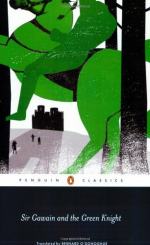|
|
Sir Gawain and the Green Knight Author/Context
The author of Sir Gawain and the Green Knight is an anonymous genius. Though several academics have made guesses as to the poet's identity since the poem's rediscovery in 1839, no concrete evidence of the man's identity has ever been uncovered. A few things are clear: the man knew French and French poetry well, lived in or came from a northwest English province, and placed great import on his Christianity and his knowledge thereof. Heralded as one of the great medieval English masterworks, equal in many respects to the works of Chaucer, Gawain was written in a particularly difficult and opaque northern dialect of English, the exact nature of which is still unknown and indecipherable. While Chaucer's work was done in a London dialect of English that was the direct antecedent of modern English, thus making him a famous partly because of his accessibility to readers then and now, the Gawain-poet's dialect died out, and faded into obscurity for several centuries. Only one manuscript of Gawain has survived to modern times, and it is a typical hand-written and error-riddled product of a medieval scriptorium, the "corrections" for which have been generally agreed upon by scholars. Although all attempts to pinpoint a date are mostly speculation, evidence from the handwriting points to a manuscript date between 1350 and 1400, placing the Gawain-poet as a direct contemporary of Chaucer's. The surviving manuscript includes three other poems, including The Pearl, over which scholars still debate whether or not to assign authorship to the Gawain-poet.
Stylistically, Gawain is part of the movement termed the "Alliterative Revival," because it marked a period in English literature that hearkened back to the poetic style of the great Old-English works, including Beowulf. Once the French conquered England in 1066, the Old-English poetic style (and even the use of the English language for literature) was phased out (or went underground) in favor of French language and French poetic style. In the 14th century, however, the English language had regained enough favor to come back into literary use, a move that Gawain represents. Gawain is written so that each line is set up around matched series of alliterations - a poetic form particularly suited for accompaniment on an instrument, particularly stringed instruments. In addition, Gawain takes on a larger form that is different from the traditional English form through the centuries, that of iambic tetrameter and A A B B rhyme schemes. Gawain is written in a newer form for the time, known as the "bob and wheel," in which each strophe of verse ends with a five line rhymed tag, which is also alliterative in its structure.
Although freely interpreted in its choice of detail, the substance of its characters in Gawain follow in a long tradition borne of the Celtic myths of great antiquity, out of which the Arthurian tradition sprouted. Literary evidence for Arthurian legend goes back to poetry from Welsh sources, the earliest dating back to 600AD.
Bibliography
Anonymous. Raffel, Burton, trans. Sir Gawain and the Green Knight. Penguin Books, New York, 1970.
"Arthurian Legend." Microsoft Encarta Encyclopedia '99. Microsoft Corporation, 1999.
The Camelot Project Web Page, at the University of Rochester. http://www.lib.rochester.edu/camelot/cphome.stm
Microsoft Encarta Encyclopedia '99. Microsoft Corporation, 1999.
Raffel, Burton. Sir Gawain and the Green Knight, An Introduction. Penguin Books, New York, 1970.
"Sir Gawain and the Green Knight." Microsoft Encarta Encyclopedia '99. Microsoft Corporation, 1999.




